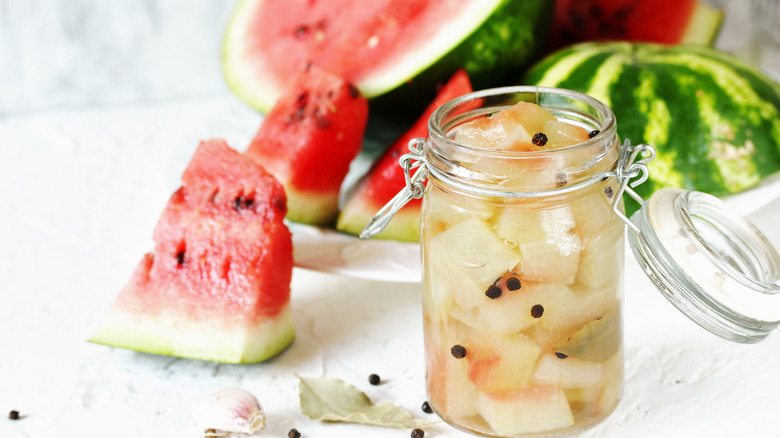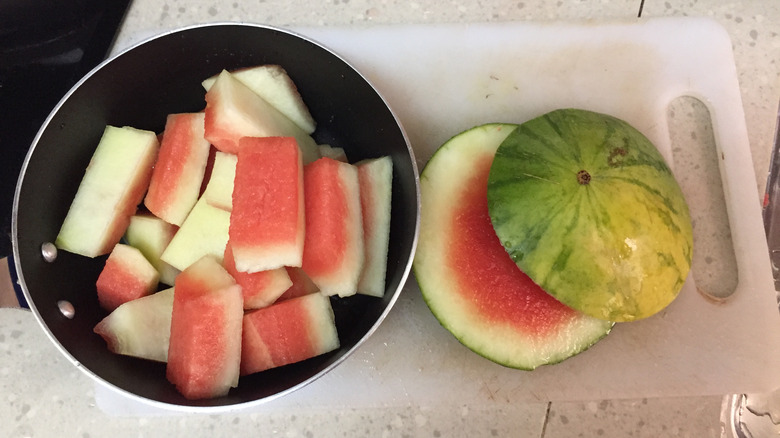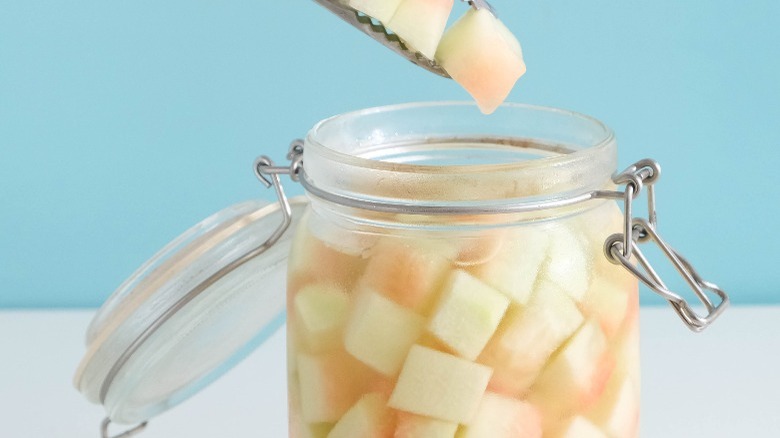Don't Throw Out Those Watermelon Rinds, Pickle Them
Fruit rinds are the kind of thing we often just toss in the trash — or the compost bin, if we're into gardening. For years, however, extra-thrifty people have been adding extra ingredients to make fruit peels more palatable, creating recipes like candied orange peels and tepache, the Mexican drink made from pineapple rind. With watermelon rind, what you get is pickles.
In Russia, German immigrants used to pickle whole watermelons, rind and all. At some point, many cooks started leaving out the rind and just pickling the flesh, but some Russian-style watermelon pickle recipes still call for leaving it on. In the 18th century, directions for preserving watermelon rind in sugar appeared in "American Cookery, or, The Art of Dressing Viands, Fish, Poultry, and Vegetables" by Amelia Simmons. This slim volume, which came out in 1797, is notable for being the first cookbook by an American-born writer to be published in this country, although we're not sure if it should also be credited with creating the first American watermelon pickles since there's no vinegar used in the recipe.
Fast-forwarding a few centuries, watermelon rind pickles are now enshrined as a traditional Southern food. Old-timey they may be, but that means they're ripe for being discovered by enthusiastic young TikTok creators who've just found out what their great-grandparents knew all along: Yes, watermelon rinds can taste pretty good if you soak them in vinegar for a few days.
How to pickle watermelon rind
As pickled watermelon rind isn't the kind of thing you can find in too many grocery stores, the easiest way to try it is to make it yourself. Acquiring the main ingredient shouldn't be too difficult, although if you're not a fan of the sticky pink fruit inside, you may need to round up some volunteers to eat it for you. Either that, or you could try pickling both fruit and rind, since the technique and ingredients aren't too different.
Once you have your watermelon rind, cut it into chunks and stick it in a jar. If you wish, you can peel the green part off the rind first, although not every recipe calls for this step. You might also want to add some flavorings such as dill, cinnamon, or chopped chiles to the mix for extra flavor. Once the pickles-to-be are in place, make the pickling liquid by boiling water with vinegar (distilled is fine, but you can use cider or rice if you prefer), sugar, and salt. Pour the liquid over the watermelon while it's still hot, then close up the jars and let them sit for an hour or so. Once the jars are cool to the touch, stick them in the fridge and allow the pickling process to continue for another day or so before you eat the rinds.
What can you do with pickled watermelon rinds?
Once you've managed to pickle watermelon rinds, they should last for a few weeks in the fridge, which will give you a little time to figure out what to do with them. Sure, you could eat them straight out of the jar if you're so inclined — who are we to judge? But if you'd prefer a fancier presentation, stick them on a plate with some sliced deli meats, cheeses, and crackers and call it a charcuterie board.
Other ways to use pickled watermelon rind include adding it to salads or coleslaw, using it on fish tacos or sandwiches, or broiling it in a bacon wrap to make hors d'oeuvres that are somewhat reminiscent of devils on horseback. PIckled watermelon rind can also be used to garnish a cocktail, particularly a watermelon-flavored one. You could even use the brine as a dirty martini ingredient if you're all out of olives.


